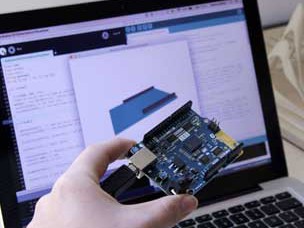
Mates Stand
The Mates Stand is an aluminium stand with integrated PCB designed to provide a base platform for MatesBUS based products for development or showcasing.
Overview
The Mates Stand offers a simple connection for a MatesBUS compatible device, such as the TIMI-96.
It eases development by propping the MatesBus compatible device up on an angle (35 degrees off vertical), aiding development when standing on a desk or bench.
The Mates Stand breaks out the ten signals found on the MatesBUS interface into two separate 5-pin headers, one out of each side of the stand itself, allowing easy connections to the Mates Programmer.
The headers are also easy to attach jumper wires to other devices or a Host, which can then be situated on a Breadboard or directly, somewhere beside or behind the stand itself.
The MatesBUS Stand utilises the BBM MatesBus, a unique interface pinout designed to be simple and easy to use.
The MatesBus is made up of 2 rows of 5 pins, 0.1” (2.54mm) pitch, spaced 0.3” (7.62mm) apart, ideal for direct plug into a breadboard or compatible adaptor or development board.
On the base of the MatesBUS stand are four mounting holes to fasten it down as required.
Get Inspired

A few weeks ago, an announcement was posted on the Arduino Forum mentioning new improvements on the software side of the Arduino/Genuino 101. With this release, the board--which was developed in collaboration with Intel--is reaching its full potential, with not only better code generation but unlocking useful features to make your sketches even more interactive as well. You can easily upgrade the core using the Arduino IDE’s Board Manager (pictured below), while Arduino Create users will be automatically updated, so no action is required--the cool thing about the cloud! In more detail: The GCC compiler has been updated to support hardware extensions to the ARC EM core in the Intel® Curie™ module. This provides significant improvements in floating point operations, bit shifting, and other operations to enhance Sketch performance. The Arduino/Genuino 101 platform offers 2MB Flash storage onboard, which is now enabled for user sketches. An experimental driver has been implemented to enable the I2S interface via the CurieI2S library. Connecting the I2S bus to an external DAC (digital to analog converter) allows users to play high-quality music (HiFi). Other improvements and bug fixes: Motion Sensor: Several sample sketches, like MotionDetection, have been implemented to demonstrate the application of the IMU data Bluetooth LE: Several new examples for BLE peripheral library added IMU: Correct motion detection setting implemented Library CurieTimerOne APIs are now compatible with the TimerOne library For comprehensive release notes refer to the Intel Open Source Technology Center on GitHub.







